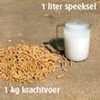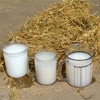|
Advice article filter
|
Natural eating habitsThe way horses eat in the wild The horse’s environment determines the behaviour it shows. Our horses cannot choose what they want to do at any specific moment. The horse as a pet cannot decide by itself when he eats, moves around, sleeps or plays with other horses. The eating habits of horses that are kept in are very different from horses that are turned out for the whole day. What do natural eating habits look like? In the wild, horses roam, looking for food and cover distances from 5 to 12 km each day. While they walk around, they take a mouthful of grass every now and then. Look at a horse in the field. You will see him walk and eat at the same time. That is exactly what the natural eating habits look like! The horse’s digestive system is designed for that. Horses cannot even eat big quantities of food as their stomach can only hold as much as half a bucket of food. The stomach contains acid. This acid improves the digestion and removes damaging materials. The acid is produced continuously. It is needed for digestion, but it is bad for the stomach wall. The acid is neutralised by certain ingredients in the saliva. In the wild, the horse eats the whole day, so there is also a constant flow of saliva going to the stomach. That makes a perfect balance between the produced acid and the neutralising saliva. In the wild the horse produces an impressive 40 to 60 liter of saliva a day!!! Roughage as healthy chewing gum A big difference between humans and horses is that a horse only produces saliva during chewing of food. We produce saliva the whole day long. That makes it very important for a horse to chew as long as possible. As a result, the saliva mixes in with the food and this makes the food more fluid. The fluid mass moves through the digestive tract a lot easier. Conclusion: extensive chewing means a good digestion and a reduced chance of digestive problems like colic. How can you encourage a horse to chew for longer periods of time? The chewing time depends mainly on the structure of the food and the volume. Compare structure rich feed like hay or haylage with cubes. To eat 1 kg of hay, the horse has to chew for not less than 40 minutes, while 1 kg of cubes takes only 10 minutes. That means that the horse produces 3 to 4 times more saliva when it eats structure rich food. Feeding in the stable A horse that does not chew enough has only a little saliva and a lot of acid in the stomach. The acid attacks the stomach walls and this can cause stomach ulcers. Those ulcers hurt and the horse will try to produce saliva. One way to do that is sucking air. How can you prevent this? Give your horse more roughage and stimulate the chewing by mixing the hard feed with Pavo DailyPlus. Winter paddocks In winter, horses are sometimes turned out in a paddock without any grass. For the horse this looks like a sandpit with a fence. There is nothing to do and nothing to eat, except for the fence itself. Put roughage down at several places in the paddock and you will see that your horse immediately starts walking around and eating. That is better natural behaviour! Bedding Research shows that a horse on wood shavings gets bored after 2 hours. With straw that rises to 13 hours, as the horse eats, investigates and plays with the straw. That is better for horses that have to stay in their stable for the whole day. It is a shame that some horses continue to eat the bedding till there is nothing left. In that case you have to try another type of bedding, but in you have to give additional roughage to keep them occupied. Longer chewing of hard feed You can also improve the length of chewing of hard feed. Structure and volume forces a horse to chew longer. That is why Pavo DailyPlus has been developed. This mix contains extra structure and is designed to mix with your normal daily ration.  
|

